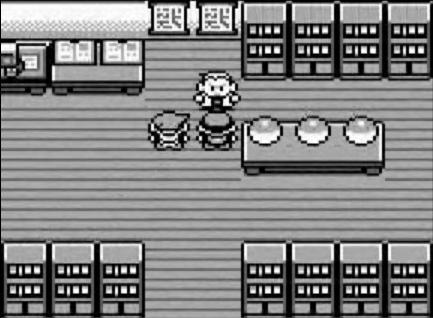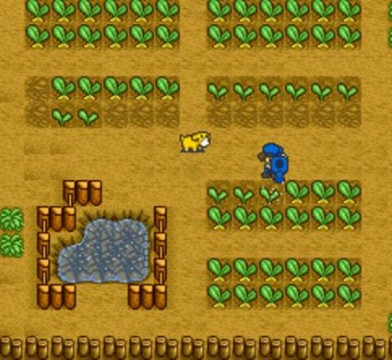
Random battles. Experience points. Epic stories. The mechanics and themes of RPGs are well known to fans of the genre, but there have been plenty of instances where developers decided to be daring and do something new. Let’s take a look at some of the games that pushed the RPG envelope to the edge and did something different!
Pokémon Red and Blue Version

Released: Game Boy, 1998
It’s easy to take the best-selling franchise for granted now, but when Pokémon hit the scene back in 1998, it played pretty fast and loose with traditional RPG conventions. Players still engaged in turn-based, random battles, but that didn’t mean Game Freak left all the apples in the cart. Pokémon brought a social aspect to RPGs unlike anything that had been seen before, facilitated by the games’ collecting and trading mechanics. Players were keen on trying to “catch ’em all,” and the quest to fill out the Pokédex brought gamers of all types together.
Further expanding its appeal, Pokémon didn’t cast the player as a knight or wizard, but a young boy on a journey through a modern (if alternate reality) Japan. The decision to stray from a medieval or hard sci-fi setting made the game more easily relatable, especially amongst younger and newer fans for whom Pokémon was their their first RPG. Pokémon broadened the horizons of RPGs, reaching a whole new audience of players and showing everyone that the genre could provide more than just insular experiences.
The World Ends with You

Released: Nintendo DS, 2008
Nintendo DS blazed the trail for touch screen gaming as players know it, but not without the help of creative video game developers to prove its legitimacy as a control input. When Square Enix introduced fans to The World Ends with You, they were met with an RPG perched on the bleeding edge. TWEWY took place in the modern, real-world setting of Japan’s Shibuya district and revolved around the exploits of Neku and a group of mysterious teenagers. With a bold and stylized aesthetic reminiscent of Sega’s Jet Set Radio, TWEWY was a lightning strike when it hit DS. It was a stark contrast from the generic medieval and sci-fi settings of so many other RPGs, and immediately made the game stand out from the crowd.
In an equally important break from tradition, combat was designed as a two-tiered system, utilizing a mixture of the D-pad and stylus strokes to create combos between the player’s character on the top and bottom screens. Integral to the battle system were a variety of “pins,” which could be collected and used to customize attacks. Though it had a bit of a learning curve, the battling in TWEWY played like nothing else and was a joy to experience, once mastered. Along with some other tweaks, like earning experience for not playing, or combining pins for more devastating attacks, TWEWY became an instant classic to anyone who played it.
Paper Mario: Sticker Star

Released: Nintendo 3DS, 2012
Paper Mario: Sticker Star might have seemed like a typical Mario RPG before it released, but once players got their hands on the title, they realized that developer Intelligent Systems took quite a few liberties with its gameplay. Two staples of RPGs, leveling up and attacking, had been completely turned upside down. RPGs generally tend to reward the completion of battles with experience points, which accumulate and level up a character in order to improve their attributes and make them more powerful. Sticker Star abandoned that, instead bestowing players with coins and stickers (more on those in a bit) in place of any visible progression. Mario did seem to become stronger as the game carried on, but the sense of growth was so intangible, it left players no incentive to engage in battles unless they were absolutely necessary. Conversely, though, it freed the player to focus more on exploring the game environment and enjoying the story.
In regards to attacking, where most RPGs offer players an ever-present assortment of moves and spells to dispatch foes, Sticker Star opted to give players a limited array of attacks that would deplete with each use. The only way to muster offense was via the game’s titular stickers, which each offered a unique attack for Mario to use. Stickers could be found in the playing field and be bought in shops, but the idea was nevertheless very unorthodox and sometimes cumbersome. Exploring environments became needlessly trepidatious affairs, as bumping into enemies and initiating battles would often result in a frustrating loss of crucial stickers. With no experience points to grind for, battles felt tedious and not worth the expenditure of stickers that would be better spent later against bosses. Still, the stickers also functioned as a means of exploring the game world, and discovering the variety of different ones available was quite fun. As a very alternative take on battling and character progression, Sticker Star took things in a radically unique direction, for better and worse.
Harvest Moon

Released: SNES, 1997
Talking to NPCs and taking on sidequests had long been a regular activity in RPGs before Natsume’s Harvest Moon landed on SNES. What made the game special, though, was that it embraced the minutiae of RPGs and dropped battling and a narrative of epic proportions for something more intimate and laid back. Harvest Moon was all about raising produce and livestock, casting players as a young man who inherited the dilapidated farm of his recently deceased grandfather. Players toiled away to bring the farm back to prosperity by harvesting crops, improving the farm, and engaged in a variety of activities ranging from egg hunts to dancing!
One of the more fascinating aspects of Harvest Moon, however, was its quirky marriage system. Players chose from a handful of lady NPCs to try and court as a wife by building a rapport and showering the prospective spouse with gifts! It took a great amount of dedication to finally be married, and it was an oddly engrossing part of the game’s appeal. Though perhaps not the most realistic take on farming or dating, the game was nonetheless a unique and entertaining title. Harvest Moon was a fearless foray into new territory for RPGs, and has built a dedicated following in the years since. Who knew growing tomatoes could be RPG gold?
The Last Story

Released: Wii, 2012
Hironobu Sakaguchi, head of developer Mistwalker and father of the Final Fantasy series, was no stranger to RPGs when it came time to develop The Last Story. His most recent forays into the genre before then were with the Xbox 360 and Nintendo DS series Blue Dragon, an underrated, albeit more traditional string of RPG titles. Though the Blue Dragon games brought their own twists to the RPG formula, nothing in those titles or anything Sakaguchi had worked on previously would compare to the deviations he would make with The Last Story.
Third-person shooter mechanics don’t normally make their way into an RPG, but The Last Story had them and used them to great effect. The game was action-packed and fast-paced, sending players scrambling for cover, slugging it out with hordes of enemies, and firing off volleys of projectiles to take down foes and parts of the environment alike. The pacing extended into the storytelling, too; rather than prattle incessantly as some RPGs tend to do, The Last Story said what it had to without extraneous exposition. With a structured, almost mission-like quality to gameplay, the narrative unfolded quickly and left the player anxious to find out what happens next. The Last Story was lean and meaty, which was no small feat in a genre glutted with heavyset meanderers. It doesn’t get the recognition of heavy-hitters like Xenoblade Chronicles, but it was every bit as ambitious and a great step forward for RPGs as a whole.
Any quirky RPGs that you loved playing? Name names in the comments!




 ShareThis
ShareThis







I think Earthbound definitely deserves a spot in this list. It was so random and off-the-wall, but held on to lots of RPG elements. One of the strangest things to me when first playing was that you didn’t die in a battle from mortal damage until the rolling counter stopped. It’s weird and cool and definitely non-traditional.
I know it’s not a nintendo rpg but Valkyrie Profile should be on here. The battle system was awesome.I also liked how you prepared your characters to be sent to fight for Odin.
Oh another one? Yep… looks like it.
Just one more great Nintendojo article, like so many others lately. You guys are on a roll.